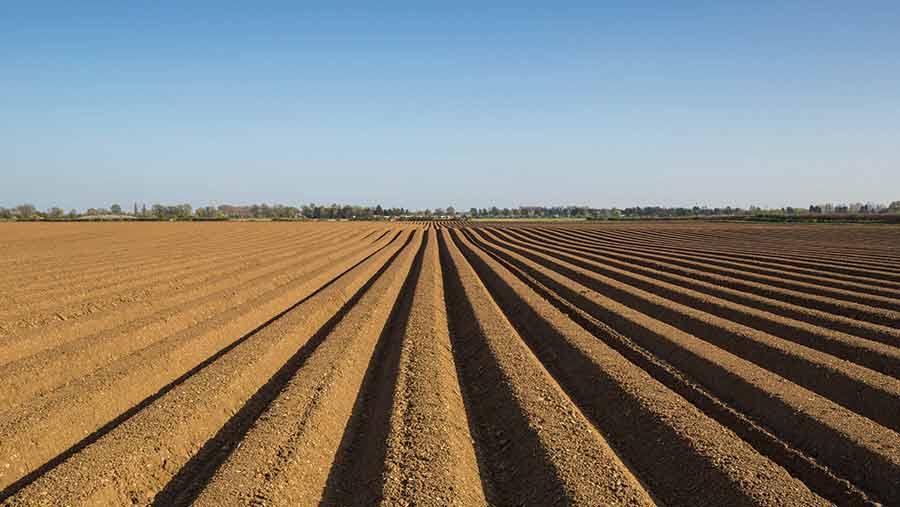New residual potato herbicide gets an independent thumbs-up
 © Tim Scrivener
© Tim Scrivener With two important residual potato herbicides under the regulatory microscope, the addition of a new active to the portfolio last year was good news.
And after a successful experience last season, two independent agronomists reckon growers should give Praxim a go in the upcoming season and learn how it fits in their weed-control programme.
Residual pre-emergence actives form the cornerstone of potato weed control and the spray timing has been dominated by the actives linuron, clomazone and metribuzin for a number of years.
Linuron is a candidate for substitution under tightening EU regulations and is on borrowed time, while metribuzin is persistent in water and could face tighter restrictions on its use.
See also: Aggressive potato contract pricing causes concern
Because of these question marks, East Anglian independent potato specialist Andy Alexander advises clients to prioritise learning how to use new actives as soon as they become available.
Praxim – residual potato herbicide
- Active metobromuron
- Timing pre-emergence only
- Rate 3-4 litres/ha
- Maximum treatments per crop 1
- Label weed spectrum Controls a range of broad-leaved, plus annual meadow grass, Cockspur and Foxtail
“Linuron has been the mainstay of potato weed control for about 25 years, but we have to learn to move on. There is still choice there, but we need to look around the corner to where we are going.
“My advice would be to give it [Praxim] a try. I used it last season on two sites with different soil types and I was very pleased,” explains Mr Alexander.
In the West, independent consultant Juliet Anderson covers Herefordshire and Monmouthshire and had Praxim on trial in 2014 and noted plots sprayed with the then unnamed product were very clean compared with others.
She used it more widely in 2015 on crisping variety Lady Claire and processing variety Ivory Russet, where linuron is the residual choice, because both varieties are susceptible to crop damage when using metribuzin.
“It has the flexibility to be used on any soil type and any variety. I have used it at the 3 litres/ha rate and it does a pretty similar job [to linuron],” adds Miss Anderson.
Partner up
Praxim is not designed as a standalone product and both advisers note metobromuron’s weakness on cleavers. Where the weed is a problem, Mr Alexander opts to add prosulfocarb-based Defy into the mix to fill the gap.
“When using any chemistry to control weeds, you need to understand what weeds are present and the limitations of what you are using. I would spray as close to crop emergence as possible, but still pre-emergence, so you will already have weeds germinated.
“It [Praxim] doesn’t have good contact activity, so it also needs to be partnered with diquat or carfentrazone,” explains Mr Alexander.
Miss Anderson also notes a slight weakness on fumitory at the product’s lower rate of 3 litres/ha and she opts to top up residual activity with Stomp (pendimethalin) and adds a contact too.
“It would be quite expensive to use Praxim at 4 litres/ha to improve fumitory control,” she adds.
Cost
When considering herbicide costs, Praxim is not as competitive as other available residuals, but Mr Alexander accepts this is a commercial reality of a new product coming to the market.
He says using lower rates bring the product down to a better price, so doesn’t see the cost as an obstacle, as long as it is performing well.
“It is important to know your weed burden and adding something to it to make sure you are controlling it all,” says Mr Alexander.
Belchim’s development and marketing manager Simon Leak acknowledges people may opt to use lower rates, with some growers using the product at 2 litres/ha last season, but he warns against going too low.
He advises a minimum application rate of 2.5 litres/ha to ensure consistent results across a range of situations, with 3 litres/ha preferable on lighter land where partner product rates may need to be cut for crop safety reasons.
“The cost of registering a new product is enormous now compared with 10 years ago. When a new product comes to market it will inevitably have a higher price than those that have been on the market for 30 years.
“Once global volumes increase, it will become cheaper per litre for us to make and that should be reflected in the cost to the grower in the future,” adds Mr Leak.

